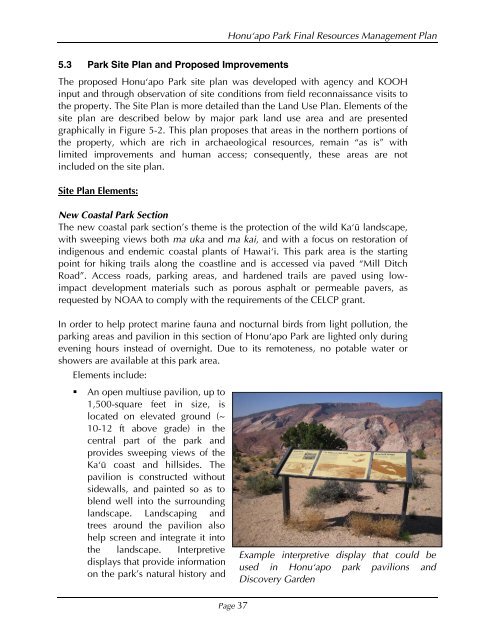Honu'apo Park Resource Management Plan
Honu'apo Park Resource Management Plan
Honu'apo Park Resource Management Plan
You also want an ePaper? Increase the reach of your titles
YUMPU automatically turns print PDFs into web optimized ePapers that Google loves.
5.3 <strong>Park</strong> Site <strong>Plan</strong> and Proposed Improvements<br />
Honuÿapo <strong>Park</strong> Final <strong>Resource</strong>s <strong>Management</strong> <strong>Plan</strong><br />
The proposed Honuÿapo <strong>Park</strong> site plan was developed with agency and KOOH<br />
input and through observation of site conditions from field reconnaissance visits to<br />
the property. The Site <strong>Plan</strong> is more detailed than the Land Use <strong>Plan</strong>. Elements of the<br />
site plan are described below by major park land use area and are presented<br />
graphically in Figure 5-2. This plan proposes that areas in the northern portions of<br />
the property, which are rich in archaeological resources, remain “as is” with<br />
limited improvements and human access; consequently, these areas are not<br />
included on the site plan.<br />
Site <strong>Plan</strong> Elements:<br />
New Coastal <strong>Park</strong> Section<br />
The new coastal park section’s theme is the protection of the wild Kaÿü landscape,<br />
with sweeping views both ma uka and ma kai, and with a focus on restoration of<br />
indigenous and endemic coastal plants of Hawaiÿi. This park area is the starting<br />
point for hiking trails along the coastline and is accessed via paved “Mill Ditch<br />
Road”. Access roads, parking areas, and hardened trails are paved using lowimpact<br />
development materials such as porous asphalt or permeable pavers, as<br />
requested by NOAA to comply with the requirements of the CELCP grant.<br />
In order to help protect marine fauna and nocturnal birds from light pollution, the<br />
parking areas and pavilion in this section of Honuÿapo <strong>Park</strong> are lighted only during<br />
evening hours instead of overnight. Due to its remoteness, no potable water or<br />
showers are available at this park area.<br />
Elements include:<br />
� An open multiuse pavilion, up to<br />
1,500-square feet in size, is<br />
located on elevated ground (~<br />
10-12 ft above grade) in the<br />
central part of the park and<br />
provides sweeping views of the<br />
Kaÿü coast and hillsides. The<br />
pavilion is constructed without<br />
sidewalls, and painted so as to<br />
blend well into the surrounding<br />
landscape. Landscaping and<br />
trees around the pavilion also<br />
help screen and integrate it into<br />
the landscape. Interpretive<br />
displays that provide information<br />
on the park’s natural history and<br />
Page 37<br />
Example interpretive display that could be<br />
used in Honuÿapo park pavilions and<br />
Discovery Garden


